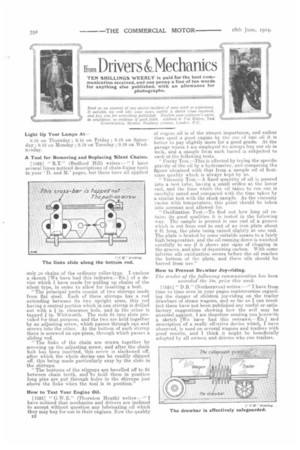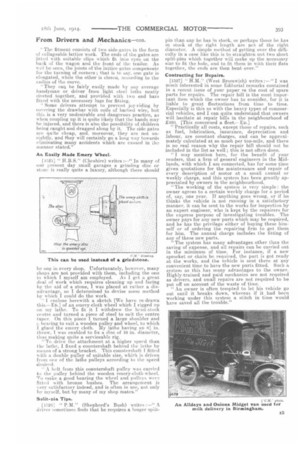Nom Drivers &Mechanics
Page 22

Page 23

If you've noticed an error in this article please click here to report it so we can fix it.
TEN SHILLINGS WEEKLY is paid for the best communication received, and one penny a line of ten words for anything else published, with an allowance for photographs.
Send vs an account of any special incident of your work or experience.
If suitable, we edit your notes, supply a sketch when required, and pay you for everything published. if cation your employer's name, in confidence, as evidence of good faith. Address to The Editor, THE COMMERCEAL MoTog. Rosebery Avenue, London, E.G.
Light Up Your Lamps At 9.18 on Thursday ; 9.16 on Friday ; 9.18 on Saturday; 9.19 on Monday ; 9.19 on Tuesday ; 9.19 on Wednesday.
A Tool for Removing and Replacing Silent Chains.
[1522] " FLT." (Bedford Hill) writes :—" I have several times noticed descriptions of chain-fixing tools in your 'D. and 111.' pages, but these have all applied tmly .zo chains of the ordinary roller-type. Lenclose a sketen [We have had this redrawn.—En.] of a device which I have made for•pulling up chains of the silent type, in order to allow for inserting a bolt.
"The principal parts consist of two stirrups made from flat steel. Each of these stirrups has a rod extending between its two upright arms, this rod having a central portion which in one stirrup is drilled out with a in. clearance hole, and in the other is tapped in. Whitworth. The rods fit into slots provided for that purpose, and the two are held together by an adjusting screw, which passes through oi,ie and screws into the other. At the bottom of each stirrup there is screwed an eye-piece, through which passes a sliding rod.
"The links of the chain are drawn together by screwing up the adjusting screw, and after the chain bolt has been inserted, this screw is slackened off. after which the whole devic& can be readily slipped off, this being made particularly easy by the slots in the stirrups.
"The bottoms of the stirzuns are bevelled off to fit between chain teeth, and to hold them in position long pins are put through holes in the stirrups just above the links when the tool is in position."
How to Test Your Engine Oil.
[1523] " C.W.E." (Thornton Heath) writes :---" I have noticed that mechanics and drivers are inclined to accept without question any lubricating oil which they may buy for use in their engines. Now the quality of engine oil is of the utmost importance, and rather than spoil a good engine by the use A d bad oil it is better td pay slightly more for a good grade. At the garage where J. am employed we always buy our on in bulk, and a sample from each barrel is subjected to each of the following tests.
" Purity Test.—This is effected by trying the specific gravity of the oil by a hydrometer, and comparing the figure obtained with that from a sample oil of firstclass quality which is always kept by us.
"Viscosity Test.—A fixed quantity of oil is poured into a test tube, having a small orifice at the lower end, and the time which the oil takes to run out is carefully noted and compared with the time taken by a similar test with the stock sample. As the viscosity varies with temperature, this point should be taken into account and allowed for.
"Oxidization Test.—To find out how long oil retains its good qualities it is tested in the following way. The sample is poured in one end of a groove which is cut from end to end of an iron plate about 6 ft. long, the plate being raised slightly at. one end. The plate is heated by some suitable means to a fairly high temperature. and the oil running down is watched carefully to see if it shows any signs of clogging in the groove, and also of depositing carbon. With some inferior oils oxidization occurs before the oil reaches the bottom of the plate, and these oils should be barred from use."
How to Prevent Drawbar Joy-riding.
The sender of the following communication has been awarded the 10s. prize this week.
[1524] " D.B." (Netheravon) writes :—" I have from time to time seen m your pages controversies regarding the danger of .children joy-riding on the trailer drawbars of steam wagons, and so far as I can recollect there have not been published any useful or satisfactory suggestions showing how the evil may be guarded against. I am therefore sending you herewith a sketch [We have had this redrawn.—ED.] and description of a really effective device which, I have observed, is used on several wagons and trailers with good results, and I think it might be beneficially adopted by all owners and drivers who run trailers.
" The fitment consists of two side-gates in the form of collapsable lattice work. The ends of the gates are fitted with suitable clips which fit into eyes on the back of the wagon and the front. of the trailer. As wiil be seen, the joints of the lattice gates compensate for the turning of corners ; that is to say, one gate is elongated, while the other is closed, according to the radius of the eurve.
" They can be fairly easily made by any average handyman or driver from light steel laths neatly riveted together, and provided with two end bars fitted with the necessary lugs for fitting_ " Some drivers attempt to prevent joy-riding by covering the drawbar with coils of barbed wire, but this is a very undesirable and dangerous practice, as when coupling up it is quite likely that the hands may be injured, and there is also the possibility of children being caught and dragged along by it. The side gates are quite cheap, and, moreover, they are not unsightly, and they will certainly go a long way towards eliminating many accidents which are caused in the manner stated!'
An Easily Made Emery Wheel.
[123] " H.B.S." (Cheshire) writes :—" In many of our present day small garages a. grinding disc or stone is really quite a luxury, although there should be one in every shop. Unfortunately, however, many shops are not provided with them, including the one in which I myself am employed. As I get a great deal of work which requires cleaning up 41.1:1(1 facing by the aid of a stone, I was placed at rather a disadvantage, so I determined to devise sonic method by which I could do the work.
" I enclose herewith a, sketch [We have redrawn this.—En] of an emery-cloth wheel which I rigged up on my lathe. To fit it I withdrew the head-stock centre and turned a piece of steel to suit the centre taper. On this piece I turned a large shoulder and 1,, bearing to suit a wooden pulley and wheel, to which I glued the emery cloth. My lathe haying an ele in. throw, I was enabled to fix a. disc of 16 in. diameter, thus making quite a serviceable rig, " To drive the attachment at a -higher speed than the lathe, I fixed a countershaft behind the lathe by means of a. strong bracket. This countershaft I fitted with a double pulley of suitable size, which is driven from one of the lathe pulleys according to the speed desired.
" A belt from this countershaft pulley was carried to the pulley behind the wooden emery-cloth-wheel, make a good bearing the wheel arid pulleys were fitted with bronze bushes. The arrangement is very satisfactory indeed, and is often in use, not only by myself, but by many of my shop mates."
Solit-pin Tips.
jr.,261 " P.M." (Shepherd's Bush) writes :—" A_ driver sometimes finds that he requires a longer split
pin than any be has in stock, or perhaps those he has in stock of the right length are not of the right diameter. A simple method of getting over the difficulty in a case like this is to straighten out two short split-pins which together will make up the necessary size to fit the hole, and to fit thetri in with their fiats together, the ends .are then bent over."
Contracting for Repairs.
[1527] " WM." (West Bromwich) writes :—" I was much interested in some Editorial remarks contained in a. recent issue of your paper re the cost of spare parts item repairs. The repair bill is the most impor
tant which the owner has to -consider, for it is liable to great fluctuations from time to time. Especially is this so with the heavy types of commer'cial vehicles, and I can quite understand that owners will hesitate at repair bills in the neighbourhood of .400. [This concerned a fleet.--ED.] " Practically all Costs, except those of repairs, such as fuel, lubrication, insurance, depreciation and labour, are constant charges, and can be approximately calculated at so much per ton-mile, and there is no real reason why the repair bill should not be
included in the list as ; this is not often done.
" I may mention here, for the benefit of your readers, that a firm of general engineers in the Midlands, with which I am connected, has for some time given quotations for the maintenance and repair of every description of motor at a small annual or weekly charge, and this system has been greatly appreciated by owners in the neighbourhood.
" The working of the system is very simple : the owner agrees to a certain weekly charge for a period of, say, one year. If anything goes wrong, or if he thinks the vehicle is not running in a satisfactory manner, it can be sent to the works for inspection by an expert engineer, who is kept by the repairers for the express purpose of investigating troubles. The owner pays for any new parts which may be required, and he has the privilege either of buying these himself' or of ordering the repairing firm to get them for him. The annual charge includes the fitting of any of these new parts. "The system has many advantages other than the saving of expense, and all repairs can be carried out in the minimum of time. For instance, if a new sprocket or chain be required, the part is got ready at the works, and the vehicle is sent there at any convenient time, to have the new parts fitted. Such a system as this has many advantages to the owner. Highly-trained and paid mechanics are not required as drivers, and small repairs are not required to be put off on account of the waste of time. "An owner is often tempted to let his vehicle go out until it breaks down, whereas if it had been working under this system a. stitch in time would have saved all the trouble."
























